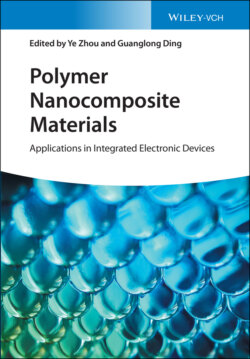Читать книгу Polymer Nanocomposite Materials - Группа авторов - Страница 43
2.4.3 Gas Sensor
ОглавлениеCPCs based gas sensors have also aroused tremendous attention for application in detecting or quantifying organic vapors or liquids chemicals [150, 151]. The electrical resistance of the CPC usually undergoes change when the sensor is exposed to organic vapor or liquid. The sensing mechanism of the gas sensor can be discussed on the basis of percolation theory. Upon exposure to vapor or liquid, the interaction between polymer matrix and gas would cause polymer expansion, resulting in the redistribution of the conductive nanofillers hence change of resistivity. Once the sensor is removed from the vapor stimuli, the resistance of the CPC recovers to its original value due to the desorption of vapor [152, 153]. Li et al. [154] proved a schematic illustration of the conductive networks formed by different fillers in sensing process shown in Figure 2.8a–d. It can be observed that the dispersion state of conductive nanoparticles (CB, CNTs) in poly(lactic acid) (PLA) matrix (Figure 2.8a,c) are quite different from that of ramie fiber (RF)/PLA (Figure 2.8b,d), resulting in different sensing mechanism. They found the addition of RF greatly tailored the vapor sensing behaviors of CB/PLA and CNTs/PLA composite.
Figure 2.7 (a) SEM image showing the surface morphology of the composite elastomers (scale bar: 10 μm); Inset photograph shows the flexibility of the film composite. (b) Schematic diagram (top) and SEM image (bottom) of the fracture surface for the composite films (scale bar: 5 μm). (c) Schematic illustration demonstrating the operation principle of the film composite. (d) The pressure sensing performance of composite film with different structures. (e) Relative resistance (R/R0) as a function of applied pressure (log–log plot) for the sensor with interlocked microdome arrays (8 wt% CNTs). Source: (a)–(e) Reproduced with permission. [149] Copyright 2014, American Chemical Society.
Many efforts have been paid to modify the sensitivity, selectivity, and recoverability of vapor sensors. Gao et al. [116] reported a superhydrophobic PU@SEBS/carbon nanofiber (CNF) composite vapor sensor to improve water proof and corrosion resistance. The superhydrophobic membrane could be easily wetted by different solvents, corresponding to a rapid response time. The sensor is also sensitive to both polar and non-polar vapors. It is obvious that the PU@SEBS/CNF composites show different sensing behavior to tetrahydrofuran (THF), toluene, and heptane as shown in Figure 2.9a–c.
Figure 2.8 Schematic illustration of conductive networks formed by carbonaceous filler in PLA during immersion-drying runs. (a–d) Illustrating the evolution of conductive networks in CB/PLA, CB/RF/PLA, CNTs/PLA, and CNTs/RF/PLA, respectively (the red lines and circles suggest the changes of conductive paths). Source: (a)–(d) Reproduced with permission. [154] Copyright 2015, Elsevier B.V.
Usually, CPCs with disordered dispersion of conductive nanofillers show poor sensing repeatability, because the swelled conductive network can't perfectly recover when the materials is taken out from the vapor in most cases. To solve this problem, CPCs with segregated structures have become alternatives [156, 157], because organic vapors or liquids could more easily be permeated in the CPC by the capillary effect generated from the interfaces of polymer matrix.
Sensor that could detect both humidity and chemical vapors with high sensitivity and low detection limit is reported by Huang et al. [155]. The obtained conductive ACNT/PU nanofiber membrane shows excellent superhydrophilicity and underwater superoleophobicity, and it is sensitive to both humidity and chemical vapors. The membrane composite can be integrated into masks to detect human respiration showing potential usage in monitoring biomarker gases from human breath (Figure 2.9d–f).
Figure 2.9 Cyclic vapor sensing behavior of the nanofiber composite with different SEBS contents to different vapors including: (a) THF, (b) toluene, and (c) heptane. Source: (a)–(c) Reproduced with permission. [116] Copyright 2018, The Royal Society of Chemistry. (d) Photos of a volunteer wearing the integrated mask, and the mask incorporated with CNC-based humidity sensor. (e) Vapor sensing behavior of the sensor to fast, normal, and deep breathing and (f) mouth and nose breathing. Source: (d)–(f) Reproduced with permission. [155] Copyright 2019, American Chemical Society.
